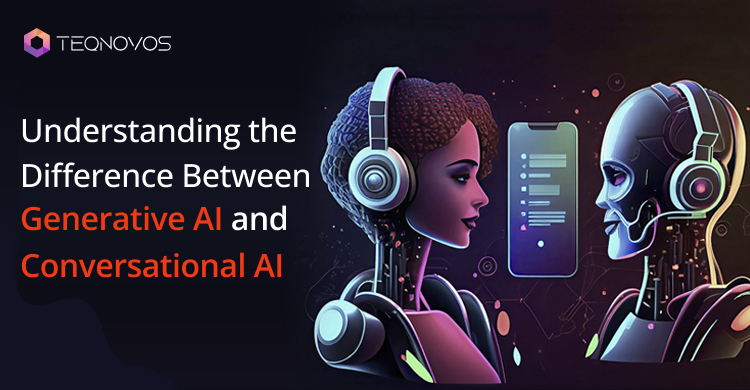Understanding the Difference Between Generative AI and Conversational AI
Generative AI and conversational AI are two prominent artificial intelligence technologies that have taken the business world by storm. Both these concepts come with their share of features and benefits that make them ideal for different businesses across the globe.
However, if you are planning to opt for these AI technologies, make sure you first understand the difference between these two. In this blog, we will take you through everything you need to know about generative AI vs. conversational AI. Let’s get started.
What is Generative AI?
Generative AI is a futuristic artificial intelligence technology that offers unparalleled opportunities in business process automation. Modern generative AI tools are capable of creating high-quality content in various formats based on the user’s personal or business requirements.
For example, you can seek assistance from reliable generative AI tools for text, image, video, and audio content generation. You will also find many new generative AI tools in the market that automate software coding making a developer’s job much easier.
As far as its working is concerned, generative AI trains its algorithms to understand large datasets. Based on the information collected through these datasets, generative AI tools can produce relevant content for the users. These tools can write blogs, captions, emails, and more.
Generative AI employs advanced machine learning techniques that let it generate meaningful, creative, and unique content every time. Today, business leaders around the world use popular generative AI tools like ChatGPT to meet their content requirements regularly.
What is Conversational AI?
Conversational AI is also the latest AI trend, but unlike generative AI, it isn’t used for content generation. Instead, conversational AI leverages the power of Natural Language Understanding (NLU) and Natural Language Generation (NLG) to generate natural human-like responses.
The goal behind this technology is to allow machines to engage in back-and-forth interactions with humans seamlessly. By using this AI model, businesses can free up their time and enhance customer experience through accelerated and personalized responses.
You can get your hands on different conversational AI solutions today that will help you transform your customer experience. Some of these include conversational artificial intelligence chatbots, interactive voice response systems, virtual assistants, etc.
Just like generative AI is trained on large datasets, conversational AI techs are also educated in datasets. However, since the latter is responsible for human interactions, it is trained on human dialogues that lets it recognize conversation patterns and respond accordingly.
Generative AI and Conversational AI: Use Cases
To understand the prime differences between generative AI and conversational AI, you must familiarize yourself with their use cases. By doing so, you will have a clear idea of what these two AI technologies are designed to be used for.
Generative AI Use Cases
1. Text Generation
First and foremost, generative AI models are used for generating top-class textual content. You can rely on these models to fulfill your business’s content requirements. From blogs and articles to website content, product descriptions, and more, you can use these tools to write anything.
However, make sure you enter relevant inputs on the tool based on what type of content you need. This will help the generative AI tool to understand and meet your expectations carefully.
2. Audio, Video, and Image Creation
Apart from text generation, you can use a generative AI tool for image, audio, and video creation as well. There are many tools available nowadays like Synthesia AI and Dall-E2 that encourage seamless image and video creation.
With generative AI, you can meet your creative content requirements comprehensively. It offers advanced features that let you create images and videos that match your brand’s tone.
3. Automated Software Coding
Lastly, generative AI is used in the software development process as well. You can find several generative AI software development tools online for automating coding. With these tools, you can speed up the development process and ensure error-free code generation.
These AI coding tools are being widely used by businesses to improve software code’s accuracy and efficiency. You can also use these AI tools for new code creation and completion.
Conversational AI Use Cases
1. Customer Support
The main use case of conversational AI is in customer support services. Companies are using conversational AI chatbots to address and respond to customer queries quickly. With its help, businesses are reducing the need for human intervention to improve customer satisfaction.
From healthcare to travel and others, many industries are benefiting from opting for conversational AI virtual assistant support. It is time-saving and does the job perfectly.
2. Personal Assistant
Many people globally are using conversational AI applications like personal assistants. These applications are built to understand and act on commands requested by the users such as playing music, turning on the lights, making phone calls, and more.
Google Assistant, Siri, and Alexa are some famous personal assistant conversational AI models that you might know of. These are among the most revolutionary conversational AI techs.
3. Language Translator
Another great application of conversational AI is its ability to act as a language translation assistant. This tool can receive information in a different language and translate it into your desired language in real-time.
You can use this tool to communicate seamlessly with someone who speaks a different language than yours. You will find many conversational AI translation applications online.
Generative AI VS. Conversational AI: What to Know?
Go through the table below carefully for a detailed comparison between generative AI and conversational AI.
| Parameter | Generative AI | Conversational AI |
| Purpose | Creating creative and unique content. | Creating human-like responses and interactions. |
| Use Cases | Used for text, image, video, and audio generation. | Used for chatbots, customer support, and virtual assistants. |
| Input and Output | Accepts both structured and unstructured data to generate unique content. | Accepts inputs from users in the form of natural language and generates context-based responses. |
| Creativity | Comparatively more creative as it creates different types of content. | Comparatively less creative as it generates custom responses. |
| Training and Learning | Trained on a wide range of data including text, images, etc. | Trained on extensive datasets with human conversations and responses. |
Generative AI and conversational AI are both popular subfields of artificial intelligence and are often misunderstood as the same. Therefore, before you decide to go for any one of these AI technologies, make sure you know what they are.
Conversational AI is the AI that focuses on generating human-like responses to streamline and fast-track customer interactions. Whereas, generative AI creates content like texts, audio, images, etc., that are used to meet a business’s content requirements.
Both generative AI and conversational AI serve different purposes, but both of them are equally important. Depending on what your company needs right now, you could benefit from opting for both these AI models when the time comes.
Convergence of Generative AI and Conversational AI
While learning the key differences between conversational AI and generative AI, it’s important to note that these two are not mutually exclusive. It means the applications of these two AIs often overlap despite their unique features and functionalities.
For example, ChatGPT is a generative AI tool with conversational AI capabilities as it can generate interactive outputs. Similarly, you will find many generative AI chatbots that have both generative capabilities and conversational AI attributes.
Bottom Line
When we talk about the latest AI technologies, generative AI and conversational AI are the first names that come to mind. Both these models have played a huge role in empowering the AI industry with their unique capabilities and fast-growing trends.
However, because of their similar nature, modern business owners often confuse them to be the same. This blog is a detailed guide on what generative AI and conversational AI are, and how they differ from one another.
If you want to build a custom generative AI or conversational AI application, get in touch with us at Teqnovos. We are a generative AI development company with a team of highly skilled AI experts. Reach out to us with your requirements, and let us build your custom app.
Frequently Asked Questions
1. What is generative AI?
Generative AI is a highly sought-after AI technology that automates several business processes such as content generation, software coding, strategy creation, etc. Modern generative AI models train their algorithms on large datasets which help them identify patterns and produce high-quality content based on the user’s needs.
2. How is generative AI different from conversational AI?
Although generative AI and conversational AI are both AI models, they have many fundamental differences. For example, generative AI tools are used for creating textual, audio, image, and video content. Whereas, conversational AI applications produce human-like responses to enhance a business’s customer experience. Thus, generative AI is different from conversational AI in terms of the type of output they generate.
3. What is an example of conversational AI?
There are many well-known conversational AI applications that you might know of. But arguably the most popular of all currently is Siri. Siri is an AI virtual assistant by Apple that uses voice recognition to understand the commands given by users and respond to them with pre-programmed answers.
4. What are the benefits of generative AI and conversational AI?
The prime benefit of both conversational AI and generative AI is business operation automation. Both these AI technologies, no matter how different, have the same goal which is to ease up business processes. For example, with generative AI you automate content generation tasks, and with conversational AI you generate relevant human-like responses.
















